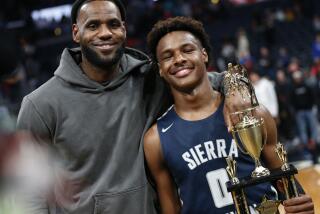MINOR LEAGUE NOTEBOOK / MIKE DiGIOVANNA : Hamelin Pulling Himself Back
- Share via
The pain in Bob Hamelin’s back was nothing compared to the sting of all those nasty things that were said about him in 1990.
In two years, Hamelin, the former Irvine High School, Rancho Santiago College and UCLA slugger, had gone from a second-round pick and can’t-miss Kansas City Royals prospect to an overweight, out-of-shape, flash in the pan.
Hamelin said it took about a year for doctors to correctly diagnose the cracked vertebra in his back, which was fused in a June, 1991, surgery. According to Hamelin, from the time he first hurt his back late in the 1989 season until the end of the 1990 season, doctors told him his injuries weren’t severe.
As Hamelin’s average dipped from .308 in 1989 to .232 in 1990 and .189 in early 1991, and as Hamelin continued to miss games because of back problems, he somehow got a reputation as a malingerer.
“When they keep telling you nothing is wrong and you’re not playing, you get a lot of negative feedback,” Hamelin said. “There were things written in the media, and I know a few people in the organization, some who are gone now, had their doubts.
“The most frustrating part was I couldn’t do anything about it because I was hurt at the time. I had to get better before I could prove them wrong.”
No one is writing Hamelin off now. The 6-foot, 235-pound first baseman has been on a tear at triple-A Omaha. He hit 11 home runs in June and is now batting .264 with 20 homers and 62 runs batted in for the season.
Hamelin’s tremendous first half came on the heels of a strong performance in the 1992 Arizona Fall League, where he hit .325 with seven homers and 37 RBIs.
“I’m 100%--I don’t feel any limitations and haven’t missed any games because of my back,” said Hamelin, who hit a state-record 31 homers for Rancho Santiago in 1988. “When you take a year off, you lose some mechanics on your swing. This year, I’m a little more comfortable at the plate.”
Hamelin went almost three years without being able to make such a claim. His biography covers only one page in the Royals’ media guide, but there are eight references to back problems.
It began in 1989, when a productive season at double-A Memphis (.308, 16 homers, 47 RBIs) was cut short by a back injury. He was diagnosed in 1990 as having a stress fracture in his back and bounced in and out of the lineup at Omaha, batting .232 with eight homers and 30 RBIs. He was even more ineffective at Omaha in 1991 (.189, four homers, 19 RBIs in 37 games).
Surgery kept Hamelin out for an entire year, from June, 1991, to June, 1992. He returned last season on rehabilitative assignment at Class-A Baseball City (.273 in 11 games) and split the remainder of 1992 at Memphis (.333, six homers in 35 games) and Omaha (.200, five homers in 27 games).
But he never found a groove.
“It was almost like three wasted seasons,” Hamelin said. “It was probably a good lesson, being at such a high point and then such a low point, because I have to learn to deal with that kind of stuff. But I’m glad to get that all behind me.”
*
What next? When Hamelin signed with the Royals in 1988, most team executives expected him to rapidly rise through the farm system. Five years and several detours later, Hamelin is finally playing well enough to warrant a call-up to Kansas City.
But there simply isn’t room for him right now. Kansas City first baseman Wally Joyner, in the first year of a three-year contract, entered the second half batting .294 with nine homers and 36 RBIs, and aging designated hitter George Brett has been solid, if not spectacular, batting .252 with seven homers and 37 RBIs for the contending Royals.
“I can’t see any changes unless someone gets hurt,” Hamelin said. “They’re not going to make too many moves when they’re doing this well. It’s a tough situation for me, but if I put up good numbers, something has to happen. Maybe if they’re in the race, they’ll trade me for something they need. It can only help you by doing well.”
There has been speculation that the 40-year-old Brett, a three-time American League batting champion with more than 3,000 career hits, will retire after the season. Hamelin, 25, thinks he could slip right into the DH role in that case.
“I think I’d have a good shot at it,” Hamelin said. “Of course, nowadays, teams bring in all kinds of people every year and rosters change all over the place. I just hope I get a shot soon.”
*
Tapping the market: Anaheim resident Barbara Durell, hoping to cash in on the growing minor league merchandising market, has launched a mail-order minor league baseball apparel business called Minor Leagues, Major Dreams.
Durell carries a variety of licensed products, including caps, T-shirts, sweat shirts, jackets, warm-ups and shorts, from all 150 minor league teams.
A Portland (Ore.) Beavers cap, which features a Beaver in uniform with a bat in hand, has been the most popular item, Durell said. Another hot item is the Carolina Mudcats cap, which features a whiskered catfish poking its head through the letter “C.”
“Some people buy hats because the logo has the same initials as their names,” said Durell, 38, who grew up watching minor league games in Fresno and Visalia. “There’s going to be a new team next year called the Portland (Me.) Seadogs, and their logos are already high in demand.”
More to Read
Go beyond the scoreboard
Get the latest on L.A.'s teams in the daily Sports Report newsletter.
You may occasionally receive promotional content from the Los Angeles Times.











